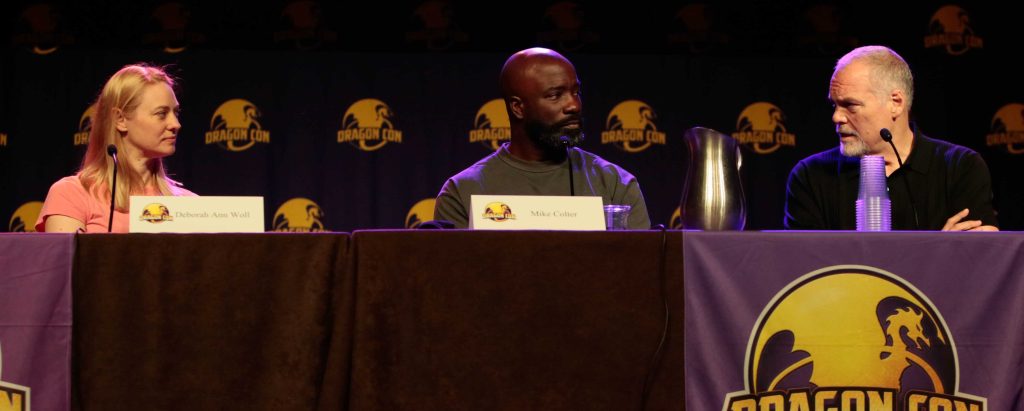
With the second half of Daredevil: Born Again yet to air on Disney Plus, curiosity ran high on Saturday at 1PM as the crowd in Hyatt Centennial II-IV awaited cast members Mike Colton, Vincent D’Onofrio, and Deborah Ann Woll. Unfortunately, the cast couldn’t give away anything about the episodes that haven’t yet aired, but they provided an hour of entertainment with their memories of acting in general and their work on the three seasons of Daredevil’s adventures in particular.
Moderator Colby Smith started the panel by noting that Daredevil: Born Again has a more serious tone than the three previous seasons of Daredevil on Netflix. He asked the actors whether they felt that it was more grounded and less like a comic book. Woll said the Avengers fight aliens and protect the world while Daredevil “defends the crap out of New York” and added that everyone does “what we can do” in any circumstances.
Questions from Discord and from audience members in line started with one to D’Onofrio about whether he relished playing a villain like Kingpin or maybe didn’t see him as villainous, just committed to a goal. The actor replied that villains keep him from being bored as an actor. He sees Kingpin as both a villain in some ways and not so bad in others. He didn’t want to romanticize playing such a character, and added that a good part is a good part.
Answering a question about what it was like to play a character who wasn’t a typical superhero, Colter replied that he lives in Harlem near where the show shoots. The area has had an influx of people from all over the world, and they’re all fans. They like to walk where Luke Cage walked. He likens the situation to his admiration of Bruce Lee in his youth. He wanted to be Bruce Lee, to be a badass, and the fact that he was Black and Lee was not didn’t matter.
He said discussing New York in the context of Marvel is odd because the real Mayor of New York doesn’t appear, nor does Spiderman or any other resident of Marvel’s New York. He pointed to a comment from Kevin Feige [the president of Marvel Studios] to the effect that it doesn’t matter how other shows depict New York, that each show should do what works for them. D’Onofrio added that New York ignites, “and not in a good way” in season two.
One questioner asked Woll to discuss the growth arc of her character, Karen Page. In Woll’s view, when Karen feels strong, she dives into the situation facing her. When she’s weak, however, she runs. When her brother died, she ran. In the fallout of Foggy Nelson’s death, Karen and Matt Murdock turned away from each other. It was a weak moment, and she ran. She needed to be alone to figure out who she was.
Smith asked how the actors prepare for deep, serious subjects, and what they draw upon to convey the related emotions. Woll replied that everyone can do that because we all respond to emotional situations. Acting requires creating strong relationships among fictional characters. Woll’s Karen loved Foggy Nelson, and Woll created memories for Karen to have of him via what she called constructive daydreaming. She drew on those emotions when reacting to Foggy’s death.
Another questioner asked Colter how he felt about Luke Cage taking over a club he had fought against. Colter saw that takeover as inevitable because of Cage’s path at the time. “With great power comes great responsibility.” Sometimes, he said, “you can’t accomplish things unless you get your hands dirty.” Then the question becomes whether being in a certain position makes a character corrupt, or is that just their nature?
A long discussion ensued about the scene between Karen Page and Kingpin in the latter’s penthouse in the third season on Netflix. Woll said that was one of her favorite scenes. She’d killed Kingpin’s righthand man, James Wesley, and came to tell him she had. If he didn’t kill her, she won. If he did, she still won because that would be public murder. The scene is one of D’Onofrio’s favorites too. He described the scene as loaded with tension. Karen had the guts to come face off against him. Filming went very smoothly, though. On the subject of character death, he added that they were “protected by the comics” from being killed. Woll laughed and said, “Speak for yourself.” [Karen Page died in Daredevil #5 (March 1999).] The actors also loved the scene because they rarely work together.
Smith asked Woll how she felt about being the moral center of the characters. Woll prefers to think of Karen less as representing the correct moral position, and more as the center between Daredevil’s “stop crime but don’t kill” philosophy and Punisher’s view that killing all criminals is best. She sees each of them as an individual. In her view, cutting off the head of the snake, Kingpin, would solve a lot of problems, but that’s tough for Matt Murdock. Karen asks a little more of the other characters.
When a questioner asked about props, Woll said Karen has a necklace she always wears, and the backstory is that it came from her mother. When she touches it, she’s engaging with her mother. D’Onofrio doesn’t have particular props. He had a chain for a while, but it didn’t work out. Colter loved a “gorgeous” chair from the show Evil. It was from David Acosta’s room in the rectory. Colter had the opportunity to buy it when the show ended but passed. Later, a fan at a convention told him the fan had bought the chair. By that time, Colter regretted passing on it. The fan sold it to him for the same price the fan had paid.
Discussing the qualities they liked best in their characters; the actors had a range of replies. D’Onofrio said Kingpin could laugh, cry, love and hate like everyone, which makes him dangerous because he can also kill to get what he wants. His relationship with his wife is unusual for an extreme villain. Woll is always curious about her characters’ flaws. Karen’s is that she’s quick to anger and sometimes reckless. Colter described Luke Cage as a fish out of water when he came to Harlem from the South to hide out. He was like the new kid at school. No one knew anything about him. Then he stepped from the shadows and started helping people, creating a new persona for himself.
Colter said he would like to see Jessica Jones and Luke Cage have a child, which would force them to figure out how to manage both parenting and crimefighting.
The actors also praised the set design and said the sets add to the reality for their characters. Parts of the set are functional, which makes them more real. The set designers are like architects for TV and movies. The set decorators also play an important role. They consider what the character would have in that space, and the actors develop memories in that area. In Netflix season one, Woll found a box and opened it. Inside were photos of Karen, Foggy, and Matt. Woll didn’t know her apartment set would be torn down after Netflix’s third season. She dashed in and took a postcard before it was destroyed.
The actors never go back and watch their own work. They are never satisfied with it and always see something they could do better. “You have to learn to just dump it off,” D’Onofrio advised.
